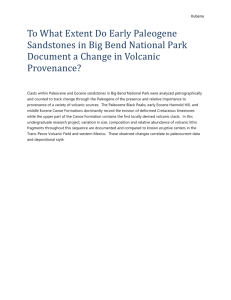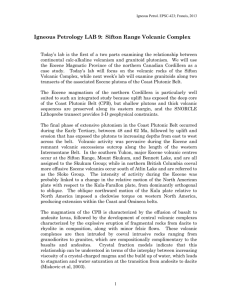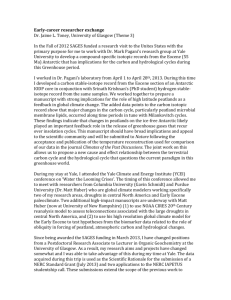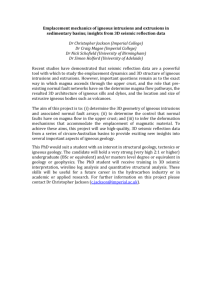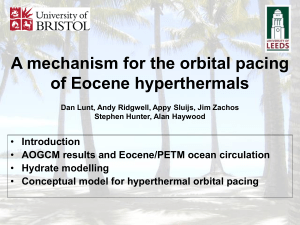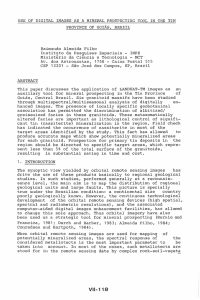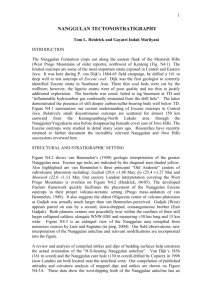IgPetLab10
advertisement
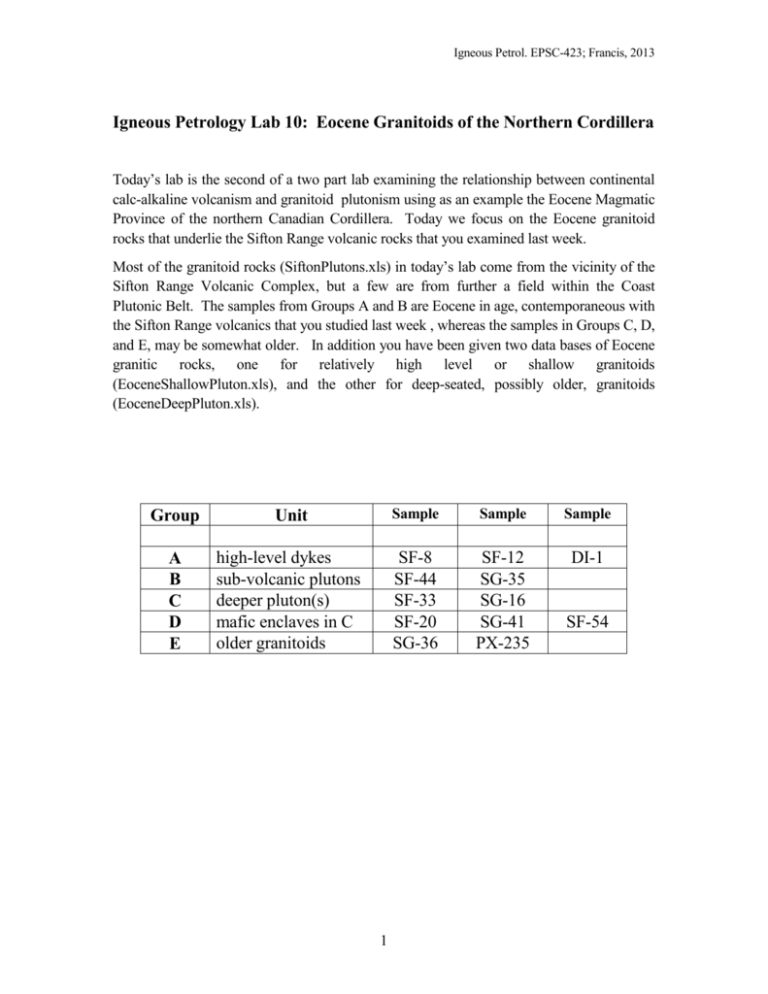
Igneous Petrol. EPSC-423; Francis, 2013 Igneous Petrology Lab 10: Eocene Granitoids of the Northern Cordillera Today’s lab is the second of a two part lab examining the relationship between continental calc-alkaline volcanism and granitoid plutonism using as an example the Eocene Magmatic Province of the northern Canadian Cordillera. Today we focus on the Eocene granitoid rocks that underlie the Sifton Range volcanic rocks that you examined last week. Most of the granitoid rocks (SiftonPlutons.xls) in today’s lab come from the vicinity of the Sifton Range Volcanic Complex, but a few are from further a field within the Coast Plutonic Belt. The samples from Groups A and B are Eocene in age, contemporaneous with the Sifton Range volcanics that you studied last week , whereas the samples in Groups C, D, and E, may be somewhat older. In addition you have been given two data bases of Eocene granitic rocks, one for relatively high level or shallow granitoids (EoceneShallowPluton.xls), and the other for deep-seated, possibly older, granitoids (EoceneDeepPluton.xls). Group Unit Sample Sample Sample A B C D E high-level dykes sub-volcanic plutons deeper pluton(s) mafic enclaves in C older granitoids SF-8 SF-44 SF-33 SF-20 SG-36 SF-12 SG-35 SG-16 SG-41 PX-235 DI-1 1 SF-54 Igneous Petrol. EPSC-423; Francis, 2013 Tasks: 1. Examine and classify each of the Sifton plutonic rock using the IUGS official classification scheme (see below). To do this, you will have to distinguish and estimate the proportions of K-spar and plagioclase, as well as quartz. Make a note of average grain-size, percent and types of mafic minerals, presence or absence of phenocrysts, types and textures of feldspars, etc., and interpret them in terms of cooling history. 2 Igneous Petrol. EPSC-423; Francis, 2013 2. Calculate the CIPW Norms in oxygen units for the Shifton granitoid rocks (SiftonPutons.xls) in this lab and plot them, along with the larger Eocene plutonic data base, in the two Quartz – Orthoclase - Plagioclase liquidus projections (Petrogeny’s Residua) from last week’s lab, one at 1 atm and the other at 5 Kbs H2O). Calculate the diagram end-members as follows: Quartz = norm Qtz Orthoclase = 1.25 × norm Or Plag = norm An + (norm Ab – 0.25 × norm Or) 1 atm. 3 Igneous Petrol. EPSC-423; Francis, 2013 3. Construct plots of the variation in the ratios of Zr/Y and Ba/Zr versus Si content in the Eocene volcanic database from last week’s lab and the shallow Eocene granitoid suites (EoceneShallowPluton.xls). In the same diagram, plot the best liquid line of descent you obtained last week using AlphMelts for closed-system crystal fractionation of the most primitive lava (PA-3. In the same diagrams, plot mixing curves between the composition of the model parent magma (PA-3) and rhyolite (SL-08). Then, run AlphaMelts AFC crystal fractionation models using the optimal conditions arrived at last week, but now including the assimilation of variable amounts of a rhyolite contaminant of SL-08’s composition. Plot the results of the best model in terms of fitting the observed volcanic data in the foregoing diagrams and comment on the ability of closed-system crystal fractionation to explain the observed variation. Finally plot the compositions of the deep seated granitoids -what is going on with these rocks in comparison to what is seen in the volcanic suite and shallow granitoids? 4. Calculate the following chemical parameters in cation units for the average composition of Eocene granites containing between 70 and 74 wt.% SiO2: Alkalinity Index = (K + Na) / Al Mg No. = Mg / (Fe + Mg) Aluminum-Saturation index = Al / (Ca×2 + Na + K) Using these chemical parameters, and your petrographic observations, classify the northern Cordilleran granitoid suite in terms of A, S, or I types according to the criteria in the attached sheet and comment on the implications for the source of these granitoids. 4 Igneous Petrol. EPSC-423; Francis, 2013 Characteristics of Granitoid Suites Feature Rock Types : Mafic Minerals: A -Type granite I - Type tonalite to granodiorite to granite Na-amphibole Na-pyroxene Accessories: fluorite topaz tourmaline Oxide: ilmenite hornblende biotite S - Type granodiorite to granite muscovite biotite garnet Al-silicates cordierite corundum magnetite ilmenite Feldspar : perthite hypersolvus K-spar & Plag subsolvus (Na+K) / Al: >1 per-alkaline <1 << 1 << 1 <1 meta-aluminous >1 per-aluminous very low low very low HFSE elements: (Zr, Nb, REE) high low low Restite/ Enclaves: few Al / (Na+K+Ca×2) Mg No. Source Regions: Tectonic Setting: granulitic lower crust with halogen volatile flux extensional within-plate amphibolite biotite-cordierite sillimanite-garnet gneiss mafic igneous rxs or mantle-derived magmas (M) sedimentary rxs compressional volcanic arcs extensional 5 K-spar & Plag subsolvus pelites greywackes compressional continental collisions
